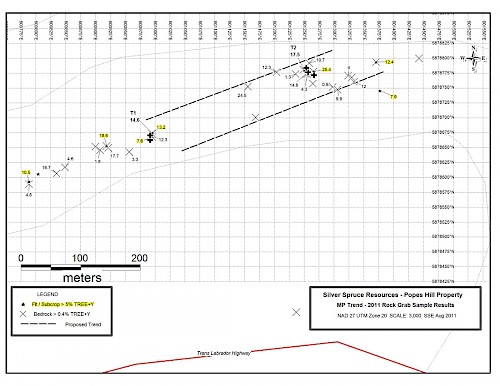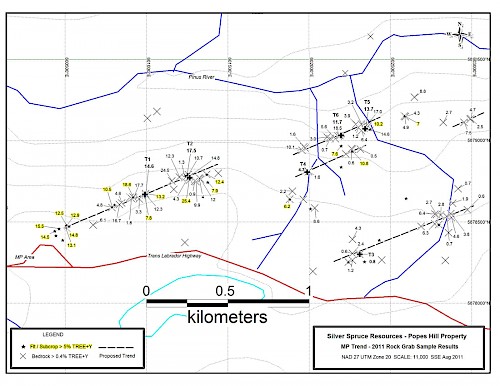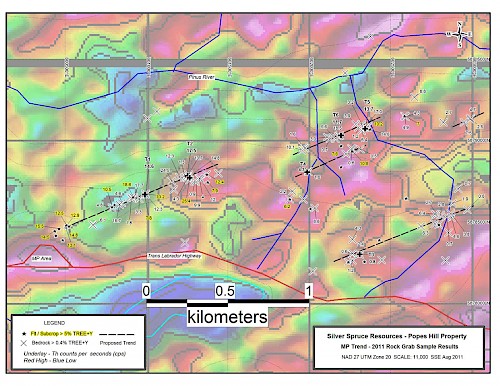Highlights
- REE bearing zone on PH - MP trend defined over an approximate 2.8 km strike length -- open
- Values to 25.4% TREE+Y, averaging 9% from outcrop / subcrop samples in the T1/T2 area
- 1 km from the Trans Labrador Highway; up to 70 m wide, averages 20 m to 30 m wide
- Parallel zone - T3 system -- values up to 6.4%, < 300 m from the Trans Labrador Highway
August 30, 2011 - Bridgewater, NS - Silver Spruce Resources Inc. (TSXV: SSE) is pleased to announce continued significant results from prospecting on the road accessible Pope's Hill (PH) rare earth element (REE) property, along the paved Trans Labrador Highway (TLH) approximately 100 km to the west of Happy Valley-Goose Bay in south central Labrador. Results were previously released on July 21 and August 9, 2011. A total of 153 samples have been submitted for analyses from the 100% owned PH property including 17 from regional exploration. Results are reported for the 136 samples along the MP trend on the original PH property. The regional results remain pending.
Most samples from the MP trend were taken from the moderately to highly radioactive, massive veins with some from the adjacent host rock. Total rare earth element plus yttrium (TREE) results range from 0.03% to 25.4%. In the T1 / T2 area, over an approximate 600 m strike length, 28 outcrop/subcrop grab samples gave an average of 8.6% TREE including 6 host rock samples with values < 1% (0.1 to 0.9%) (see map on website). Heavy rare earth (HREE) percentages ranged from 2.7% to 47.6%, averaging 12.7%, with 16 > 10% HREE. The average values of the rare earth elements and yttrium in this zone are as follows: 16,652 ppm (1.67%) La, 36,417 ppm (3.64%) Ce, 4,135 ppm (0.41%) Pr, 15,351 ppm (1.54%) Nd, 2,552 ppm (0.26%) Sm, 62 ppm Eu, 1,977 ppm (0.2%) Gd, 287 ppm Tb, 1,512 ppm (0.15%) Dy, 261 ppm Ho, 633 ppm Er, 74 ppm Tm, 379 ppm Yb, 49 ppm Lu, and 5,716 ppm (0.57%) Y. It should be noted that since these are grab samples they are not representative of the overall values in the zone.
The 136 samples from the MP trend give HREE percentages ranging from 1.1% to 47.6%, averaging 8.4%, including 45 values > 10% HREE. The average values of the rare earth elements and yttrium are as follows: 10,083 ppm (1.00%) La, 21,364 ppm (2.14%) Ce, 2,570 ppm (0.26%) Pr, 8,425 ppm (0.84%) Nd, 1,422 ppm (0.14%) Sm, 44 ppm Eu, 1,019 ppm (0.10%) Gd, 149 ppm Tb, 750 ppm (0.075%) Dy, 130 ppm Ho, 314 ppm Er, 37 ppm Tm, 191 ppm Yb, 25 ppm Lu and 2,775 ppm (0.28%) Y. Thirty (30) samples gave P2O5 values > 2% with a high of 11.6% and preliminary studies have shown that REE mineralization, with higher HREE content, is present in apatite (calcium phosphate) and apatite content should be reflected by P2O5 values. Thorium values for the radioactive, higher grade, REE samples, are generally in the 0.2% to 0.4% range.
Prospecting, using scintillometers to locate radioactive mineralization, along the PH -- MP trend has traced laterally continuous, rare earth element (REE) mineralization in subcrop/outcrop over an approximate 2.8 km strike length and the zone remains open to the east. The zone extends along trend from north of the the MP showing in the pit on the TLH, through the T1 and T2 showings located 800 m and 1,100 m, to the east, to the T5 and T6 showings located 2,000 m and 2,200 m to the east near the brook where a boulder running 24% TREE was found in 2010 (news release dated October 28, 2010). Outcrops with massive, vein type mineralization are located along the MP trend in all the northern "T" showings with other areas of mineralization noted between the showings but not fully exposed. The mineralized unit, a syenite to monzonite, which is not well exposed, is up to 70 m wide, averaging 20-30 metres wide, and carries green pyroxene phenocrysts up to 5 cm long. It remains open along strike. The host rock unit and the REE bearing veins appear to be generally conformable with the lithology (the strike of the rock units). The massive, high grade veins, up to 30 cm wide, which typically run 10-25% TREE, are characterized by pinch and swell structures with two parallel veins, separated by 5 m to 6 m of host rock noted in the T1, T 2, T5 and T6 exposures and other massive veins exposed in hand dug pits in the same areas, thought to be part of the same system, but up to 30 m across strike indicating the mineralized unit is likely much wider than now exposed.
The exposures will be exposed by trenching and then channel sampled to determine the grades and widths of the occurrences. This work should begin in the next few weeks. This will be followed by a diamond drilling program to test the mineralized zone at depth.
Regional exploration consisting of stream sediment geochemical sampling with limited prospecting should be completed this week, with a total of 550 samples taken to date at 300 m intervals on streams draining the prospective areas to the north and west of the Churchill River over the 100% owned properties. A number of radioactive zones have been noted in the prospecting surveys with rock samples taken from these areas. All results for the regional stream and rock sampling surveys remain pending.
Follow up of prospects located in the regional exploration will be carried out once results have been received to allow trenching and possible drilling of targets in the late fall and early winter.
All samples are transported to the Activation Labs preparation facility in Goose Bay by SSE personnel, then shipped to their laboratory in Ancaster, ON. for analysis using their 8 REE package. Uranium analyses are carried out using ICP MS, with higher values re-run using a DNC technique. The laboratory uses internal standards to check their analyses and blanks are included in each sample batch.
Plan maps of the properties, showing the sample results to date, the airborne Th radiometric and magnetic data plus pictures showing the area, the showings and some of the higher grade samples, are shown on the Silver Spruce website at silverspruceresources.com.
This release has been approved by Peter M. Dimmell, P.Geo. President and CEO of Silver Spruce Resources Inc., who is a Qualified Person (QP) in NL and ON. as defined in National Instrument 43-101.
ABOUT SILVER SPRUCE
Silver Spruce is a diversified junior exploration company with a portfolio of rare earth (Pope's Hill, Pope's Hill JV (with Great West Minerals Group), MRT, RWM and the Straits), gold silver (Big Easy), and for the longer term, uranium (CMBJV, Snegamook, Double Mer, Mount Benedict), projects in Newfoundland and Labrador. With interests in more than 4,000 claims totaling more than 1,000 square kilometers in Labrador, Silver Spruce is one of the largest landholders in one of the world's premier emerging rare earth and uranium districts.
For Further Information Contact:
SILVER SPRUCE RESOURCES
HEAD OFFICE
Gordon Barnhill, CFO & Director
Phone: 902.527.5700
Fax: 902.527.5711
E-mail: gbarnhill@silverspruceresources.com
Web: www.silverspruceresources.com
INVESTOR RELATIONS
Hugh Oswald, Ascenta Capital Partners Inc.
Phone: 604.684.4743 ext. 243
Toll Free: 1.866.684.4743 ext. 243
E-mail: hugh@ascentacapital.com
Web: www.ascentacapital.com



